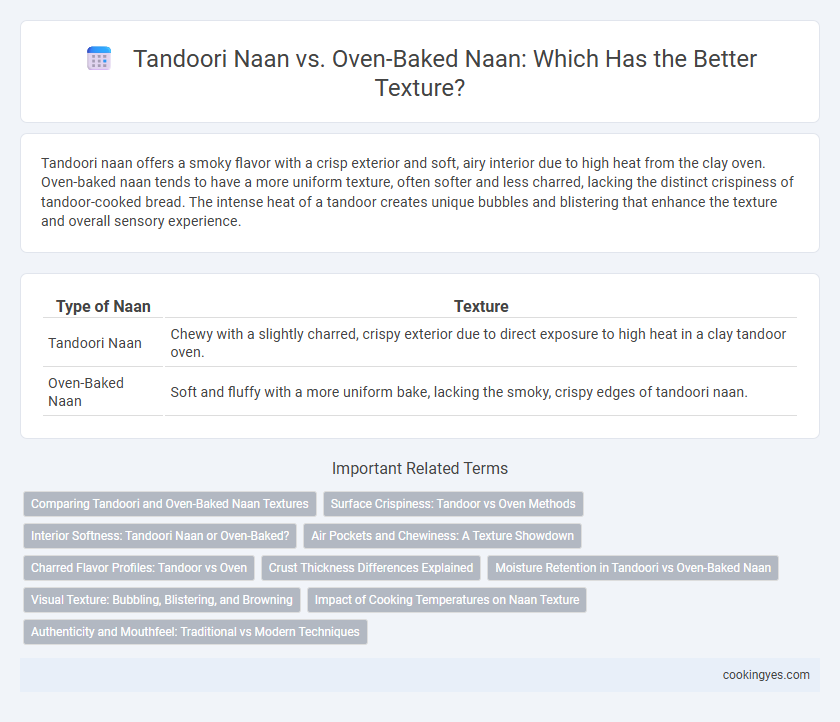Tandoori naan offers a smoky flavor with a crisp exterior and soft, airy interior due to high heat from the clay oven. Oven-baked naan tends to have a more uniform texture, often softer and less charred, lacking the distinct crispiness of tandoor-cooked bread. The intense heat of a tandoor creates unique bubbles and blistering that enhance the texture and overall sensory experience.
Table of Comparison
| Type of Naan | Texture |
|---|---|
| Tandoori Naan | Chewy with a slightly charred, crispy exterior due to direct exposure to high heat in a clay tandoor oven. |
| Oven-Baked Naan | Soft and fluffy with a more uniform bake, lacking the smoky, crispy edges of tandoori naan. |
Comparing Tandoori and Oven-Baked Naan Textures
Tandoori naan features a distinct charred exterior and smoky flavor due to cooking in a clay tandoor at high temperatures, resulting in a slightly crispy yet chewy texture. Oven-baked naan tends to have a softer, fluffier texture with a more uniform golden crust, as it is baked at lower temperatures without direct flame exposure. The tandoor's intense heat causes rapid cooking and slight blistering, whereas oven baking produces a gentler rise and tender crumb.
Surface Crispiness: Tandoor vs Oven Methods
Tandoori naan develops a distinctively crisp and charred surface due to direct exposure to the high heat of the clay tandoor, creating smoky, blistered spots that enhance texture and flavor. Oven-baked naan, cooked on a hot baking stone or tray, results in a more even but softer crust with less pronounced surface crispiness. The tandoor's intense heat generates rapid moisture evaporation, producing a uniquely crisp exterior not easily replicated by conventional ovens.
Interior Softness: Tandoori Naan or Oven-Baked?
Tandoori naan boasts a superior interior softness due to its high-heat cooking environment in the clay tandoor, which quickly seals moisture inside, resulting in a tender and fluffy crumb. Oven-baked naan, while often slightly denser, may lack the same degree of interior softness because it cooks at a lower temperature for a longer time, causing more moisture loss. The intense radiant heat of a tandoor creates a characteristic airy texture that oven baking struggles to replicate.
Air Pockets and Chewiness: A Texture Showdown
Tandoori naan features prominent air pockets resulting from the high heat of the clay tandoor, creating a light, fluffy texture with a slightly charred exterior and chewy bite. Oven-baked naan tends to have a denser crumb and fewer air pockets, yielding a softer, more uniform chewiness without the smoky flavor characteristic of tandoori cooking. The difference in cooking methods directly impacts the texture, with tandoori naan offering a superior contrast between crisp edges and pillowy interior compared to the even, tender texture of oven-baked naan.
Charred Flavor Profiles: Tandoor vs Oven
Tandoori naan features a distinctive charred flavor and crisp exterior due to the intense heat and smoky environment of the clay tandoor, enhancing its texture with a slight crispness balanced by a soft, chewy interior. Oven-baked naan typically lacks the pronounced smoky char, resulting in a more uniformly soft texture and milder flavor profile without the characteristic tandoor crispiness. The tandoor's unique cooking method imparts a complex, slightly charred aroma that oven baking cannot replicate, making it a preferred choice for authentic naan enthusiasts.
Crust Thickness Differences Explained
Tandoori naan features a thicker, crispier crust due to the intense, direct heat of the clay tandoor oven, which locks in moisture while creating charred, smoky edges. Oven-baked naan tends to have a thinner, softer crust because of the gentler, uniform heat distribution in conventional ovens, resulting in a more evenly baked surface with less charring. These crust thickness differences impact the overall texture, making tandoori naan chewier and more robust compared to the tender, delicate feel of oven-baked naan.
Moisture Retention in Tandoori vs Oven-Baked Naan
Tandoori naan achieves superior moisture retention due to the intense, radiant heat of the clay tandoor, which quickly seals the dough's surface, locking in softness and preventing dryness. Oven-baked naan often results in a drier texture as the heat is less direct and more diffuse, leading to increased moisture evaporation during baking. The unique cooking environment of the tandoor produces a tender, chewy crumb with a slightly charred exterior, enhancing overall moisture preservation compared to conventional oven baking.
Visual Texture: Bubbling, Blistering, and Browning
Tandoori naan exhibits a distinctive visual texture with pronounced bubbling and blistering caused by intense heat exposure from the clay oven, creating charred spots that enhance flavor complexity. Oven-baked naan displays a more uniform browning with fewer bubbles, resulting in a softer crust and consistent texture throughout. The charred blisters on tandoori naan contribute to its rustic appearance and crisp edges, making it visually and texturally unique compared to the smoother, lightly browned surface of oven-baked naan.
Impact of Cooking Temperatures on Naan Texture
Tandoori naan, cooked at temperatures reaching 480degC (900degF) inside a traditional clay tandoor, develops a characteristic charred exterior with a soft, airy interior due to rapid heat exposure and intense radiant heat. Oven-baked naan, typically cooked at 220-250degC (430-480degF), results in a denser texture with less pronounced blistering and a chewier consistency because of slower, more even heat distribution. The high heat of the tandoor promotes steam generation inside the dough, creating unique leavening and a distinctive fluffy texture compared to the more uniform crumb structure found in oven-baked naan.
Authenticity and Mouthfeel: Traditional vs Modern Techniques
Tandoori naan, cooked in a clay oven at high temperatures, boasts an authentic smoky flavor and a distinct charred texture that delivers a soft yet slightly crispy mouthfeel, preserving the traditional essence of Indian cuisine. Oven-baked naan tends to have a more uniform texture, often softer and less charred, reflecting modern baking methods aimed at convenience and consistency. The choice between tandoori and oven-baked naan significantly influences the sensory experience, with tandoori naan favored for its authentic taste and textured depth.
Tandoori naan vs Oven-baked naan for texture Infographic

 cookingyes.com
cookingyes.com